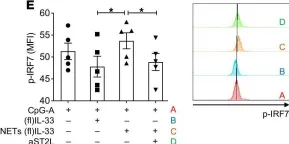IL-33, a nuclear alarmin released during cell death, exerts context-specific effects on adaptive and innate immune cells, eliciting potent inflammatory responses. We screened blood, skin, and kidney tissues from patients with systemic lupus erythematosus (SLE), a systemic autoimmune disease driven by unabated type I IFN production, and found increased amounts of extracellular IL-33 complexed with neutrophil extracellular traps (NETs), correlating with severe, active disease. Using a combination of molecular, imaging, and proteomic approaches, we show that SLE neutrophils, activated by disease immunocomplexes, release IL-33-decorated NETs that stimulate robust IFN-α synthesis by plasmacytoid DCs in a manner dependent on the IL-33 receptor ST2L. IL33-silenced neutrophil-like cells cultured under lupus-inducing conditions generated NETs with diminished interferogenic effect. Importantly, NETs derived from patients with SLE are enriched in mature bioactive isoforms of IL-33 processed by the neutrophil proteases elastase and cathepsin G. Pharmacological inhibition of these proteases neutralized IL-33-dependent IFN-α production elicited by NETs. We believe these data demonstrate a novel role for cleaved IL-33 alarmin decorating NETs in human SLE, linking neutrophil activation, type I IFN production, and end-organ inflammation, with skin pathology mirroring that observed in the kidneys.
Product Citations: 2
In JCI Insight on 8 November 2021 by Georgakis, S., Gkirtzimanaki, K., et al.
-
FC/FACS
Toxoplasma gondii Inactivates Human Plasmacytoid Dendritic Cells by Functional Mimicry of IL-10.
In The Journal of Immunology on 1 January 2018 by Pierog, P., Zhao, Y., et al.
Plasmacytoid dendritic cells (pDCs) are the major producers of IFN-α, an antiviral cytokine involved in immunomodulation and control of HIV type 1 replication, whereas Toxoplasma gondii is a life-threatening opportunistic infection in AIDS patients. During infection with HIV type 1, human pDCs decrease in circulation and remaining pDC produce lower amounts of IFN-α in response to viral stimulation. In this study, we investigated the impact of coinfection with T. gondii on the innate virus-directed responses of human pDCs. Using intracellular flow cytometry and fluorescence microscopy, we determined that T. gondii invaded but did not induce IFN-α or TNF-α in human pDC. However, T. gondii inhibited IFN-α and TNF-α produced in response to HSV and HIV, thus functionally inactivating pDC. IFN-α production was inhibited only in cells infected by T. gondii, which inhibited neither uptake of GFP-HSV nor localization of TLR9 in CD71+ endosomes, directing us to investigate downstream events. Using imaging flow cytometry, we found that both T. gondii and IL-10 inhibited virus-induced nuclear translocation, but not phosphorylation, of IFN response factor 7. Blockade of IFN response factor 7 nuclear translocation and inhibition of the IFN-α response was partially reversed by a deficiency in the T. gondii-derived ROP16 kinase, known to directly phosphorylate STAT3, a critical mediator of IL-10's anti-inflammatory effects. Taken together, our results indicate that T. gondii suppresses pDC activation by mimicking IL-10's regulatory effects through an ROP16 kinase-dependent mechanism. Our findings further imply a convergent mechanism of inhibition of TLR signaling by T. gondii and IL-10 and suggest potential negative consequences of HIV/T. gondii coinfection.
Copyright © 2017 by The American Association of Immunologists, Inc.
-
Immunology and Microbiology
In JCI Insight on 8 November 2021 by Georgakis, S., Gkirtzimanaki, K., et al.
Fig.7.E

-
FC/FACS
-
Collected and cropped from JCI Insight by CiteAb, provided under a CC-BY license
Image 1 of 1
